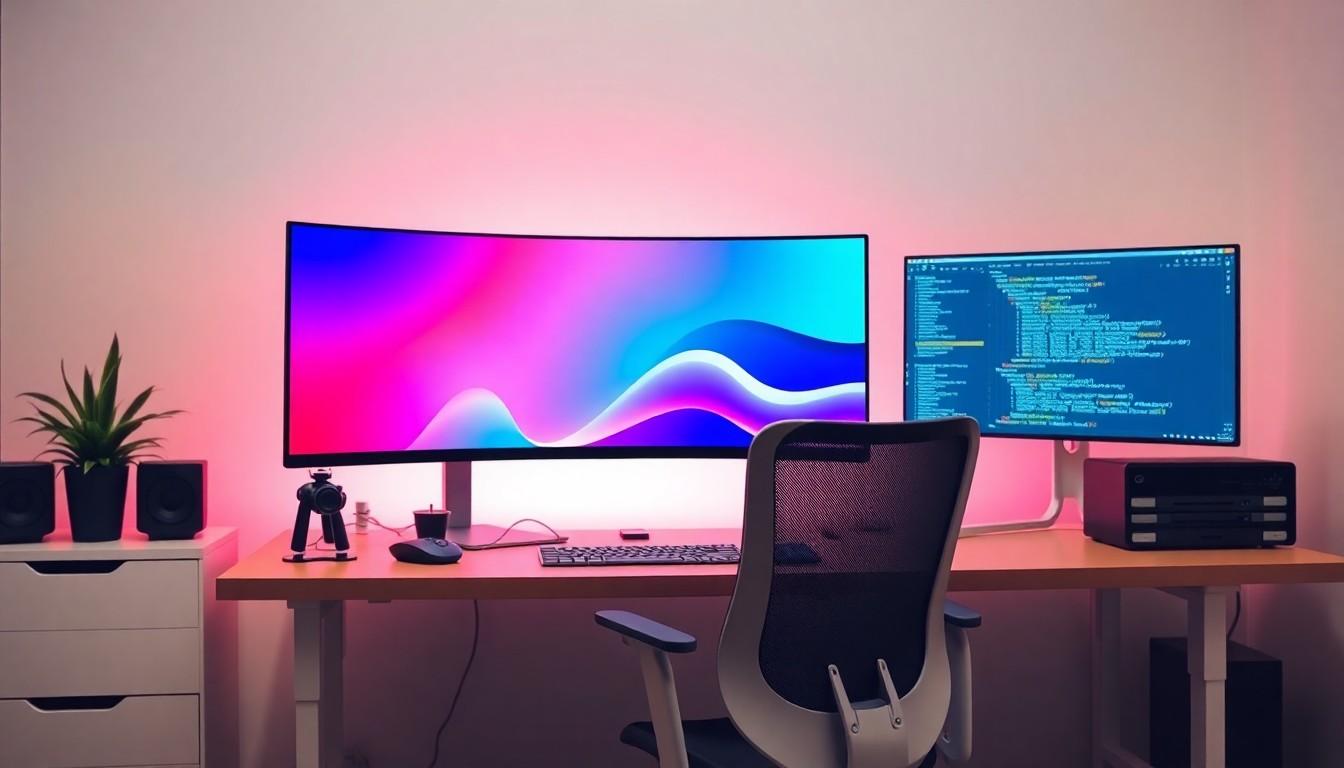Key Takeaways
- Monitor Resolution Matters: Aim for a minimum of 1080p; consider 4K for detailed visuals, especially for design work.
- Optimal Screen Size: Select monitors between 24 to 32 inches for comfort; larger screens, like 34 inches UltraWide, enhance multitasking.
- Panel Type Influences Quality: IPS panels are ideal for color accuracy and wide viewing angles, while TN offers speed and VA provides good contrast.
- Ergonomics Enhance Comfort: Look for monitors with adjustable stands, blue light filters, and flicker-free technology to reduce eye strain and promote comfort during long coding sessions.
- Connectivity Options: Ensure your monitor has various ports like HDMI, DisplayPort, and USB-C for versatility and easy transitions between devices.
- Refresh Rates for Tasks: A refresh rate of 60Hz suffices for coding, but consider higher rates for gaming and media consumption to improve visual fluidity.
In the world of programming, having the right tools can make all the difference. A high-quality monitor not only enhances productivity but also reduces eye strain during those long coding sessions. With countless options available, choosing the best monitor for programming can feel overwhelming.
From resolution and screen size to refresh rates and ergonomic features, each aspect plays a crucial role in creating an efficient workspace. Programmers need monitors that can handle multiple windows and provide clear visuals, ensuring they can focus on their code without distractions. This guide will explore the top monitors that cater specifically to the needs of programmers, helping them find the perfect fit for their setup.
Best Monitor For Programming
Selecting the best monitor for programming involves evaluating essential features that enhance the coding experience. High-resolution displays provide clearer text and reduce eye strain, making them critical for long hours of work. Monitors with at least 1080p resolution offer sufficient clarity, while 4K monitors suit programmers requiring finer detail.
Screen size plays a significant role in productivity. Monitors ranging from 24 inches to 32 inches foster a comfortable viewing experience. Larger screens accommodate multiple windows, enhancing multitasking efficiency.
Refresh rates are vital for those who engage in gaming during breaks. A minimum refresh rate of 60Hz suffices for standard coding tasks, but monitors above 120Hz improve visual fluidity for gaming and media consumption.
Ergonomic features also contribute to a comfortable workspace. Adjustable stands and VESA compatibility allow for better positioning, reducing neck strain. Blue light filters and flicker-free technology further minimize eye fatigue, supporting long working hours.
Programmings’ best monitor prioritizes resolution, size, refresh rate, and ergonomics. Investing in the right equipment significantly boosts productivity and comfort.
Key Features To Consider

When selecting a monitor for programming, it’s essential to evaluate various features that enhance productivity and comfort. Focus on screen size, resolution, panel type, color accuracy, and ergonomics.
Screen Size and Resolution
Screen size significantly impacts coding efficiency. Monitors between 24 and 32 inches provide a comfortable viewing area. A resolution of at least 1080p (Full HD) is recommended for sharp text clarity, while 4K (3840 x 2160) resolution offers even greater detail and reduces eye strain. Larger screens accommodate multiple windows, aiding multitasking.
Panel Type
Panel type influences viewing angles and color reproduction. IPS (In-Plane Switching) panels deliver superior color accuracy and wide viewing angles, making them ideal for coding. TN (Twisted Nematic) panels usually offer faster response times but may lack color fidelity. VA (Vertical Alignment) panels provide good contrast but may not match IPS in color consistency.
Color Accuracy
Color accuracy impacts the quality of on-screen visuals. Monitors with high color accuracy (covering 99% sRGB or more) ensure that colors appear true to life. This feature is especially important for programmers who work with design elements or need precise color representation in their projects.
Ergonomics and Adjustability
Ergonomic features enhance comfort during long coding sessions. Monitors with adjustable stands allow users to set the optimal height and angle, reducing neck strain. Additional features like blue light filters and flicker-free technology minimize eye fatigue. Prioritizing these elements creates a conducive working environment and sustains productivity.
Top Picks For Best Monitors
Here are top selections for monitors that enhance programming efficiency, productivity, and comfort during long coding sessions. Each option features key specifications and benefits.
Option 1: Dell UltraSharp U2720Q
- Screen Size: 27 inches
- Resolution: 3840 x 2160 (4K)
- Panel Type: IPS
- Refresh Rate: 60Hz
- Color Accuracy: 99% sRGB, 95% DCI-P3
- Ergonomics: Height, tilt, swivel, and pivot adjustments
- Ports: USB-C, HDMI, DisplayPort
The Dell UltraSharp U2720Q provides excellent color accuracy and detail with a 4K resolution. Its IPS panel offers wide viewing angles, making it suitable for design work. Ergonomic features ensure comfort during extended use.
Option 2: ASUS ProArt PA278QV
- Screen Size: 27 inches
- Resolution: 2560 x 1440 (QHD)
- Panel Type: IPS
- Refresh Rate: 75Hz
- Color Accuracy: 100% sRGB, Calman Verified
- Ergonomics: Height, tilt, swivel, and pivot adjustments
- Ports: DisplayPort, HDMI, USB
The ASUS ProArt PA278QV combines impressive color accuracy and versatile connectivity options, catering to programmers and designers alike. The QHD resolution balances clarity and performance, while its ergonomic features enhance comfort.
Option 3: LG 34WN80C-B
- Screen Size: 34 inches
- Resolution: 3440 x 1440 (UltraWide QHD)
- Panel Type: IPS
- Refresh Rate: 60Hz
- Color Accuracy: 99% sRGB
- Ergonomics: Height and tilt adjustments
- Ports: USB-C, HDMI, DisplayPort
The LG 34WN80C-B offers an immersive ultrawide experience, allowing for enhanced multitasking with split-screen functionality. The IPS panel delivers vibrant colors and clarity, while a height-adjustable stand promotes ergonomic comfort.
Tips For Choosing The Right Monitor
- Identify Your Resolution Needs
Identify a minimum resolution of 1080p for basic programming tasks. Opt for 4K if engaging in graphic design or video editing to enhance clarity.
- Consider Screen Size
Consider a screen size between 24 and 32 inches for optimal viewing comfort. Larger screens, such as 34 inches UltraWide, facilitate improved multitasking.
- Evaluate Panel Types
Evaluate panel types such as IPS for vibrant colors and wide viewing angles. Choose TN for faster response times or VA for strong contrast based on the primary use case.
- Assess Color Accuracy
Assess color accuracy if working on design projects or web development. A monitor with at least 99% sRGB coverage boosts color representation.
- Examine Refresh Rates
Examine refresh rates; a minimum of 60Hz supports smooth coding tasks. For gaming, consider higher refresh rates that enhance visual fluidity.
- Check Ergonomic Features
Check for ergonomic features such as height-adjustable stands. Eye strain reduces significantly with monitors that offer tilt, swivel, and pivot functionalities.
- Factor in Connectivity Options
Factor in connectivity options such as HDMI, DisplayPort, and USB-C to support various devices. Multiple inputs ease the transition between different setups.
- Review Additional Features
Review additional features like blue light filters and flicker-free technology. These features enhance comfort during long programming sessions.
Choosing The Right Monitor For Programming
Choosing the right monitor for programming is a crucial decision that can significantly impact productivity and comfort. By focusing on key features like resolution, screen size, and ergonomic design, programmers can create an efficient workspace tailored to their needs. High-quality displays not only enhance visual clarity but also reduce eye strain during long coding sessions.
Investing in a monitor with the right specifications ensures a more enjoyable and productive coding experience. With options available that cater to various preferences and requirements, programmers can find the perfect fit to support their work and enhance their overall performance. Prioritizing the right monitor is a step toward achieving greater efficiency and satisfaction in programming tasks.
